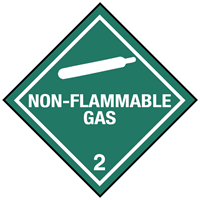
 Print
Print
Chemical Datasheet
LIQUEFIED GAS (NONFLAMMABLE) |

|
Chemical Identifiers
| CAS Number |
UN/NA Number |
DOT Hazard Label |
USCG CHRIS Code |
|
none
|
|
|
none
|
| NIOSH Pocket Guide |
International Chem Safety Card |
|
none
|
none
|
NFPA 704
data unavailable
General Description
Liquids other than those classified as flammable, corrosive or poisonous. Charged with nitrogen, carbon dioxide, or air for the purpose of expelling the liquid from the container. Under prolonged exposure to fire or heat the containers may rupture violently and rocket.
Hazards
Reactivity Alerts
none
Air & Water Reactions
No rapid reaction with air. No rapid reaction with water.
Fire Hazard
Excerpt from ERG Guide 120 [Gases - Inert (Including Refrigerated Liquids)]:
Non-flammable gases. Containers may explode when heated. Ruptured cylinders may rocket. (ERG, 2024)
Health Hazard
Excerpt from ERG Guide 120 [Gases - Inert (Including Refrigerated Liquids)]:
Vapors may cause dizziness or asphyxiation without warning, especially when in closed or confined areas. Vapors from liquefied gas are initially heavier than air and spread along ground. Contact with gas, liquefied gas or cryogenic liquids may cause burns, severe injury and/or frostbite. (ERG, 2024)
Reactivity Profile
Almost any reducing agent and all hydrocarbons can form explosive mixtures with liquefied air [Chem. Eng. News 27:2612. 1949]. Explosions have occurred when liquid air contacts organic matter. A cracked tube of activated charcoal immersed in liquid air exploded violently [J. Sci. Inst. 5:24. 1928]. Allyldimethylarsine ignites in air and on filter paper [NFPA 491M. 1991]. The slow reaction between nitrogen dioxide and formaldehyde becomes explosive in the region of 180°C [Trans. Faraday Soc. 45:767-770, 1949]. Nitrogen dioxide and ozone react with the evolution of light, and often explode [J. Chem. Phys. 18:366. 1920]. Contact of very cold liquefied gas with water may result in vigorous or violent boiling of the product and extremely rapid vaporization due to the large temperature differences involved. If the water is hot there is the possibility that a liquid "superheat" explosion may occur. Pressures may build to dangerous levels if liquid gas contacts water in a closed container [Handling Chemicals Safely 1980].
Belongs to the Following Reactive Group(s)
Potentially Incompatible Absorbents
No information available.
Response Recommendations
Isolation and Evacuation
Excerpt from ERG Guide 120 [Gases - Inert (Including Refrigerated Liquids)]:
IMMEDIATE PRECAUTIONARY MEASURE: Isolate spill or leak area for at least 100 meters (330 feet) in all directions.
LARGE SPILL: Consider initial downwind evacuation for at least 100 meters (330 feet).
FIRE: If tank, rail tank car or highway tank is involved in a fire, ISOLATE for 800 meters (1/2 mile) in all directions; also, consider initial evacuation for 800 meters (1/2 mile) in all directions. (ERG, 2024)
Firefighting
Excerpt from ERG Guide 120 [Gases - Inert (Including Refrigerated Liquids)]:
Use extinguishing agent suitable for type of surrounding fire. If it can be done safely, move undamaged containers away from the area around the fire. Damaged cylinders should be handled only by specialists.
FIRE INVOLVING TANKS: Fight fire from maximum distance or use unmanned master stream devices or monitor nozzles. Cool containers with flooding quantities of water until well after fire is out. Do not direct water at source of leak or safety devices; icing may occur. Withdraw immediately in case of rising sound from venting safety devices or discoloration of tank. ALWAYS stay away from tanks in direct contact with flames. (ERG, 2024)
Non-Fire Response
Excerpt from ERG Guide 120 [Gases - Inert (Including Refrigerated Liquids)]:
Do not touch or walk through spilled material. Stop leak if you can do it without risk. Use water spray to reduce vapors or divert vapor cloud drift. Avoid allowing water runoff to contact spilled material. Do not direct water at spill or source of leak. If possible, turn leaking containers so that gas escapes rather than liquid. Prevent entry into waterways, sewers, basements or confined areas. Allow substance to evaporate. Ventilate the area. CAUTION: When in contact with refrigerated/cryogenic liquids, many materials become brittle and are likely to break without warning. (ERG, 2024)
Protective Clothing
Excerpt from ERG Guide 120 [Gases - Inert (Including Refrigerated Liquids)]:
Wear positive pressure self-contained breathing apparatus (SCBA). Structural firefighters' protective clothing provides thermal protection but only limited chemical protection. Always wear thermal protective clothing when handling refrigerated/cryogenic liquids or solids. (ERG, 2024)
DuPont Tychem® Suit Fabrics
No information available.
First Aid
Excerpt from ERG Guide 120 [Gases - Inert (Including Refrigerated Liquids)]:
Refer to the "General First Aid" section. Specific First Aid: Clothing frozen to the skin should be thawed before being removed. In case of contact with liquefied gas, only medical personnel should attempt thawing frosted parts. (ERG, 2024)
Physical Properties
Chemical Formula:
data unavailable
Flash Point: data unavailable
Lower Explosive Limit (LEL): data unavailable
Upper Explosive Limit (UEL): data unavailable
Autoignition Temperature: data unavailable
Melting Point: data unavailable
Vapor Pressure: data unavailable
Vapor Density (Relative to Air): data unavailable
Specific Gravity: data unavailable
Boiling Point: data unavailable
Molecular Weight: data unavailable
Water Solubility: data unavailable
Ionization Energy/Potential: data unavailable
IDLH: data unavailable
AEGLs (Acute Exposure Guideline Levels)
No AEGL information available.
ERPGs (Emergency Response Planning Guidelines)
No ERPG information available.
PACs (Protective Action Criteria)
No PAC information available.
Regulatory Information
EPA Consolidated List of Lists
No regulatory information available.
CISA Chemical Facility Anti-Terrorism Standards (CFATS)
No regulatory information available.
OSHA Process Safety Management (PSM) Standard List
No regulatory information available.
Alternate Chemical Names
- LIQUEFIED GAS (NONFLAMMABLE)
- LIQUEFIED GASES, NON-FLAMMABLE, CHARGED WITH NITROGEN, CARBON DIOXIDE OR AIR
- LIQUEFIED NONFLAMMABLE GAS, [CHARGED WITH NITROGEN, CARBON DIOXIDE, OR AIR]


 Print
Print
